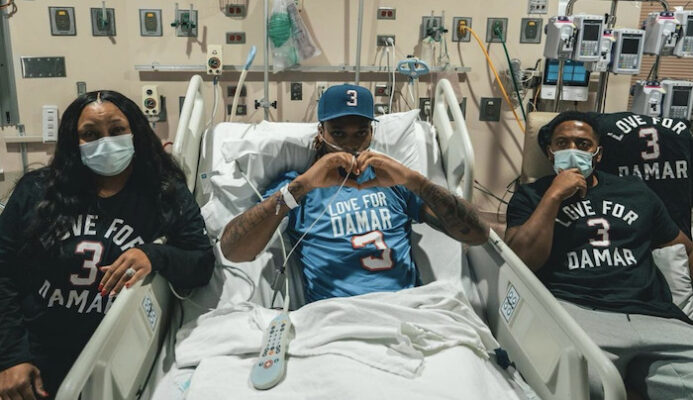
Imagine this: you’re a typical 24-year old-athlete getting ready for your Sunday night football game. Everything is going well, and then you get tackled, — which is. You get up, and you get ready to start another play before time slows down. But then, you fall onto your back. Everything goes black, and when you wake up, you’re in a hospital room with a breathing tube down your throat. Health care workers are surrounding you, and they give you a whiteboard to write on so that you can talk.
This is exactly what happened to Damar Hamlin, who plays safety for the Buffalo Bills.
It was an extremely scary scenario that shocked the world — especially when he was resuscitated on the field before being rushed to the hospital.
If you’re a first responder or work in a health care setting, this is something you’re probably familiar with. Unfortunately, those of us in health care see more situations like this than we’d like to. The one thing that kept Hamlin alive long enough to get him to the hospital was the athletic trainer who recognized that he’d gone into cardiac arrest and immediately administered CPR.
I’ll be honest with you — CPR looks extremely aggressive.
CPR usually cracks ribs as soon as you start it, and unless you continue to hear them crack when you push down, you’re not doing it correctly. CPR is the only way to get circulation back through the heart and transfer it to the vital organs to keep someone alive or bring them back. I can only imagine the adrenaline rushing through the athletic trainer’s body as he performed CPR in front of thousands of people and millions of TV viewers.
After Hamlin entered the ICU, doctors released what happened to him. Hamlin’s body experienced commotio cordis This occurs when an object or person hits your chest wall hard enough to cause your heart to go into ventricular fibrillation and then cardiac arrest.
Commotio cordis is an extremely rare occurrence — it happens to fewer than 30 people per year. It only happens when a heart is at a specific point in the heartbeat cycle.
The way to help save people with commotio cordis? CPR and defibrillation. Both need to happen immediately, and even then, the person experiencing symptoms of this deadly condition may not make it.
I’ll be honest: I didn’t expect Hamlin to live through commotio cordis.
He was down a long time during CPR, which lowered the odds that he could make it. Hamlin’s age and overall health undoubtedly helped him survive. This is one of those miracles that healthcare workers know so well. Hamlin’s odds didn’t look good, but thankfully, he survived.
Ultimately, the athletic trainer who performed CPR and the hospital staff helped Hamlin make a full recovery. That’s why those of us who work in health care go to school for so many years and do thousands of hours of clinicals before we work in the “real world.” We have to prepare for situations no one could expect and stay calm in intense moments that would shake most people. Sometimes we can’t even fully process the aftermath of what we saw until we leave our shift. We have to keep caring for our other patients — no matter what happened earlier that day.
So if you know someone who works in health care, tell them “thank you.” People don’t often tell us how well we do our jobs or how much they appreciate us. It often takes situations like this to open up the world’s eyes to what working in health care is really like.
I’m truly grateful that Damar Hamlin’s now recovering back at home with family and friends. It’s all thanks to healthcare workers, so thank one today.
Featured Photo via Damar Hamlin


















